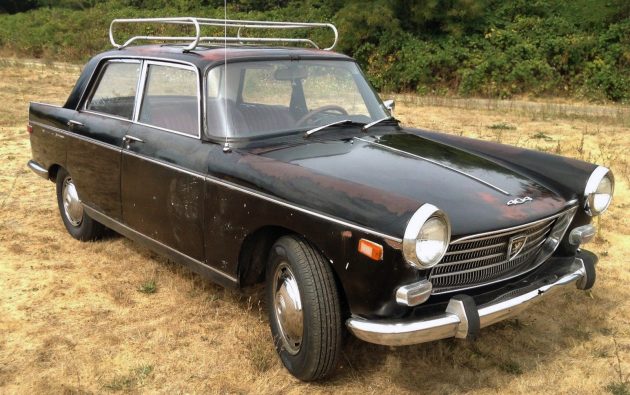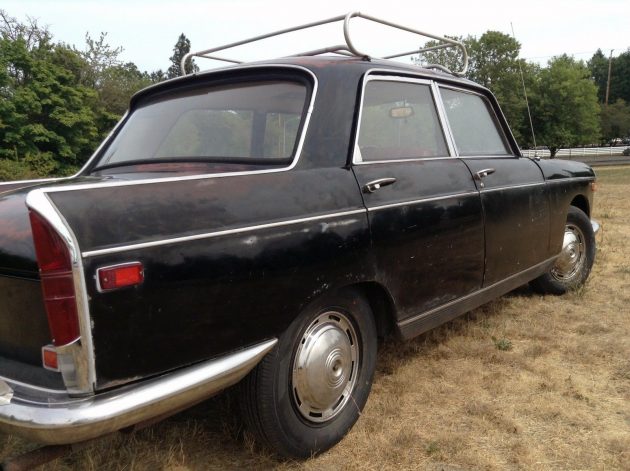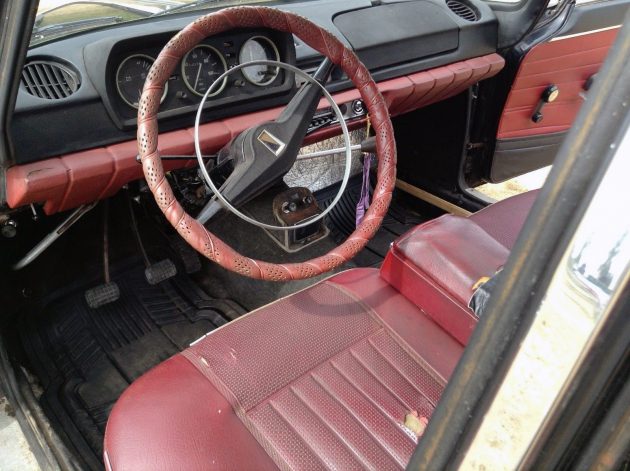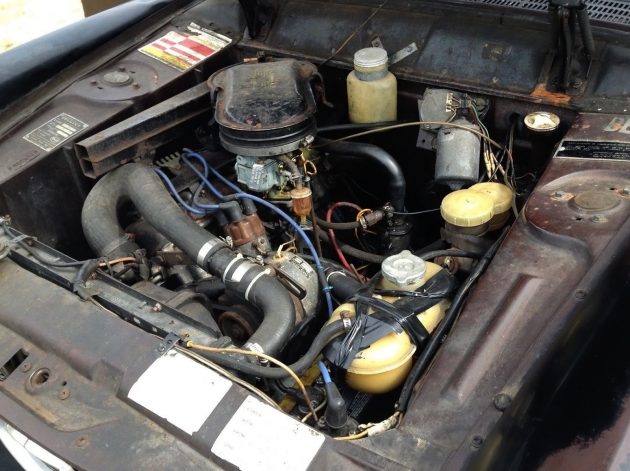How’s this for French patina? French folks sure know their coffee, but do their cars have patina? Maybe that’s just an American car/truck thing. This 1969 Peugeot 404 Sedan looks like it’s about as straight of an example as you’ll find and it sure looks great in this well-worn paint, in my opinion. It adds a bit of old world (or, olde world, as they say in the strip mall world) charm. It’s listed on eBay in beautiful Portland, Oregon, a city that knows a thing or two about quirky vehicles, patina, and French press coffee.
This one has some crazy crazed spots in the paint that are begging to be wet-sanded and clear-coated. Or, with such an elegant car, a full, nice respray in black would be fantastic. The owner “just installed new battery and four new steel belted radial tires” so that’s one less thing for the next owner to think about. This is one crisp critter, and in beautiful black, no less. The Peugeot 404 was made from 1960 to 1975 and it’s quite a formal design with more than a little Mercedes-Benz going on in the overall form, especially the rear portion.
See what I mean? At first glance, other than the tail lights, some folks may have thought that this was an early-60s Mercedes-Benz from the rear 3/4 angle. It’s an elegant car and this one is all original, or at least it hasn’t been restored or painted or otherwise messed with. 2.9-million of them were made so they couldn’t have been quite as horrible as many people think French cars are. In case you aren’t one of those people and haven’t noticed, a lot of folks like to poke fun at French vehicles.
An unusual, black car with a red interior? Yes, please. And, is that a third pedal!? Yes, pretty please! The interior looks fairly decent but it could use some help. The dash looks good other than a crack-and-a-half and the back seat looks like new. The rare factory sunroof works and the seller says that “all gauges work. All lights, EXCEPT brake light, work. The brake light problem is in the floor mounted switch.” The brakes, in general, need help as the “power brake booster has a fluid leak and pressure leak. The car can be driven as a non-power brake vehicle but the brake pressure fades and the fluid level needs to be monitored. I do not and I would not recommend driving it far or fast until the brakes are fixed. But I do drive it as is, with that knowledge.”
The seller says that the “clutch and transmission are butter-Smooth. The only other car that I have ever owned with such a smooth balanced transmission was my 1974 Alfa.” Cool. This is Peugeot’s 1.6L inline-four with 80 hp for North American cars. With the four-speed manual transmission it’s good for a 0-60 time of between 14 and 15 seconds, or about twice what your Chevy Volt will do. For anyone with some basic skills and who likes unusual vehicles, this could really be a fun car to own.






I love the looks…does the sale include a tweed sport coat with elbow patches? By the way, It looks like the biggest thing in the engine bay is the alternator. The fact that you can see everything but the engine block explains the 80 HP…
This is not your typical four-on-the-floor! Is it a 4 on the column or a 4 on the tree????
Four-on-the-tree. Not uncommon for the French: Some DS/ID-model Citroens had the same, as did the Renault 16.
There were exceptions. The Euro-spec Renault 16TX had a FIVE-on-the-tree, as did my American-Spec 16 after a friend shipped over a 5-speed transaxle from France for me.
If Columbo had a family this would have been his family sedan. Patina is to a worn car like mold is to really old/aged French cheese.
Neat sedan. Another unrelated tangent, although French….I didn’t realize Chrysler riped off its French connection with Simca in developing the Omni/Horizon.
BaT beat you to this one BF. :(
Car fan from the front: “What kind of Japanese car is that?”
Car fan from the rear: “Hey, look — it’s some kinda Soviet car!”
Peugeot continued to build these to sell in Africa long after they’d been superceded elsewhere because they were simple and fairly indestructible. Styling by Farina, which is why it looks very similar to the AustinCambridge and its siblings.
Four times the Peugoet 404 won the East Africa Safari Rally, including three years in a row, in the 1960’s.
Google this rally for more amazing background imformation.
They were used as taxis in many far Eastern countries, in demanding situations, and pick up versions were often overloaded to the point of ridiculousness in poorer African nations! But still they soldiered on, often for many years. The Estate car version became well known too especially with long distance travellers. They had to be kept under strong lock & key with an armed security guard when not in use in some nations of Africa, such was the demand for them.!
Always loved the 404 they ride very nice and have great seats if you drive it easy it will get you there and back with a smile always wanted one. Most of the ones i saw as a kid in South America had the sunroofs very fond memorys of a buy gone era for me 1962-1965.
The US Peugeot 404 support group has a very informative web site owners stories, history and shop manuals
https://www.peugeot404na.com/production-history
Gr8 cars Greg
Having owned a 59 Mercedes, I can tell you that a 4sp on the collum can be puzzling to some folks. Peugeots are really good quality. It was Renault who gave French cars such a bad rep.
I had an earlier one than this when my first wife and I lived in Anchorage. My mother was up there too, and we did a lot of day trips over all the interesting roads and through the great scenery. A delightful cruiser, it was the first car I’d ever had that always went faster than it seemed to, something I had to watch carefully as the speedometer had quit on Day One. Despite the rather puny claimed power, it always seemed to be enough, even going up mountains. If it hadn’t gotten rear-ended hard I might even still have it. Of course the insurance company totaled it … and then about six months later I saw it in downtown Anchorage, rear end still jacked up like a cat in heat, but the trunk lid was off of it, and there were feed sacks and a hay-bale or two in there. And then this grizzled old dude walked up, got in, and drove away. Made me kind of happy.
I had two of these, a ’69 automatique in Colorado and a four-speed ’71 in California. Would buy another four-speed, but I’d like the wagon this time…
Down here in Australia we owned one for 38 years. It was assembled by Renault on the Australian production line in CKD form.
The engine is canted 45 degrees to lower the bonnet line. It had a crumple type bonnet and front panels as a safety feature. If you surf the net you will find a test with a real human driver, driving a 404 into a tree to show how ‘safe’ it is.
The basic engine was fitted in the later 504 and some 505 models hence parts are still around. The engine has wet cylinder liners. The basic 404 was 1618cc (84×73). There was as smaller version I think only for France. Late models and some utility versions had an 1796c engine (84×81). The 504 used a 1971cc version (88×81). Most 1600 engines had a single barrel solex carb. The 1800 had both single & double barrel carbs. The 1971 had a double barrel and some emission vehicles had a strange twin carb set up. They had both a double and single barrel carb.
The inlet manifold was cast inside the head. As the porting was quite large as well as large valves used, the cars can cruise easily at high speeds. The carb just bolts to the head with a 45 degree J-piece.
The radiator cooling fan used a magnetic clutch. Radiators were quite small and the radiator in the black car above is not original as the top inlet is on the wrong side plus it is about double the width.
All engines were available with the Kuglefisher fuel injection similar to the Bosch L-jetronic. These were a lot more powerful.
The 404 & early 504 sedans had a bronze crown wheel de-dion rear end with transverse panhard rod. All drive load was taken at the back of the gear box. A torque tube was used with only one universal joint.
The station wagon variants were longer in wheel base with huge hypoid drive rear ends (with massive diameter axles that would handle an American V8). The 404 & 504 wagon rear end had two coil springs per side at the rear (one front & one rear of the axle tube). With light loads only one spring took the load and when the load was increased the second spring came into action.
Some station wagons had a seven-seat option with all seats facing forward. High roof ambulance versions were sold.
The flat top utility was quite a different vehicle on a separate chassis. It used the same engines and almost identical body panels plus probably the hypoid differential but the coils were replaced by a heavy set of long leaf springs.
Our car was a 1618cc 80hp version and advertised gear speeds for the 4-speed box were 35, 55, 84 & 96mph. At high speeds you could feel the rear end float around the radius of the transverse panhard rod.
Our car was quite reliable. I changed the clutch at 180,000 miles but only because the arm that held the clutch release bearing had fractured which I understand was one of the faults of the design. I think the clutch plate was 10 inch or 10&1/2″diameter and with only 80hp is the reason they didn’t often wear out. Our original clutch plate still had plenty of material on it.
Rust spots are behind the front guards and the removable side plates below the doors. Also, the trunions for the frame supports behind the suspension on each side rust.
Late model 404s were fitted with 12 & 3/4″ diameter Bendix front disc brakes and magazine road tests indicated there was no measurable fade. Rear sedan drums were 10 inch but the wagons and utilities were fitted with massive 12×2 inch rear drums.
The power booster (mentioned in the story above) can be repaired and I did it twice on our car but splitting the two halves of the vacuum chamber was a bit of an effort as they have to be twisted apart.
I still have a few spares if anyone purchases the black car.
Are these from before Peugeöt gained the reputation for a supple almost Magic Carpet ride quality (and “No I’m NOT getting it confused with Citroen & their Hydraulic suspension systems”), or was this still from when they were more handling orientated? Thanx
I was in Egypt ten years ago and 75 percent of.the taxis were 404’s or.504’s. We had a taxi hired foDay5’days, at $20′ a Day. 40 years old, caught fire one afternoon, driver yanked some wires out and put it out. One window crank we passed around. He. Rarely used 1st used too.much gas. The rest were Ladas, left over from Nassar and the Soviets.
I owned, in succession, a Peugeot 403, a 404 and a 204 2-seater convertible. I loved the brand for its reliability as much as for its quirkiness. But even reliable cars inevitably need repairs, and Peugeot pats distribution was a disaster in the U.S., so I ultimately gave up on the brand. To the best of my recollection, among 403s and 404s sold in the U.S. a factory sunroof was not rare. It was standard. They all had them. They did not crank, however. They slid back by hand.